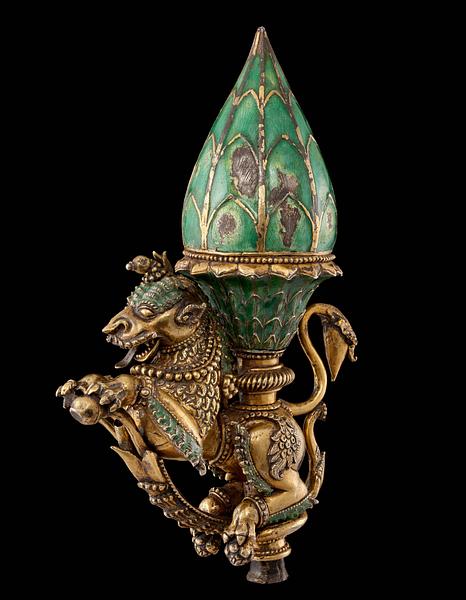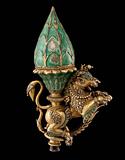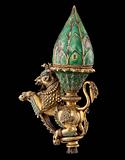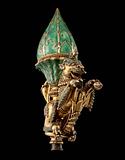The ornament depicts a rearing lion with a demon-like face, curled horns, gaping maw and lavish adornments on its body, comprising strings of beads, vines and flowers. Known as a
yali, this lion figure originates from Hindu mythology.
Yalis often appear in South Indian Hindu temple architecture, for example as gatekeepers, but in the fifteenth century the sultans of the Deccan adopted the imposing mythical creature as a symbol of power. In the sixteenth century,
yalis came to adorn many fortress walls and city gates in cities such as Bidar and Golconda.
[1] Yalis also appear on many smaller art objects from the Deccan, such as a carved ivory book stand (
7/2022) and a dagger with a gilded bronze hilt which may have belonged to Sultan Ali Adil Shah I of Bijapur (
36/1997 and
6/2013).
A closed lotus bud rises up from the back of the lion figure. Like parts of the
yali’s fur, the tongue-shaped leaves of the bud are covered in semi-transparent, green enamel paint. Enamelling was a European decoration technique which presumably came to the Deccan and the Mughal Empire via the Portuguese colony of Goa. Exactly when Indian artisans adopted the technique is unclear, but sources confirm that enamelwork was produced in the court workshops of the Mughal emperor Akbar around the year 1590.
[2] Only a few Indian enamel objects from the first half of the seventeenth century have survived (for example
34/2019). This lion figure must have been among the earliest experiments with the new art form.
At the bottom, the ornament terminates in a short, round socket, suggesting that it may have been a finial on a post, perhaps on a royal piece of furniture. The Deccan and the Mughal Empire both had a tradition of richly decorated thrones and palanquins, and a miniature from c. 1614 shows the Mughal emperor Jahangir on a throne decorated with two duck figures with unfurled lotus flowers on their heads.
[3]
_The-David-Collection_Copenhagen_photo-Pernille-Klemp.jpg?locale=en)
_The-David-Collection_Copenhagen_photo-Pernille-Klemp.jpg?locale=en)
_The-David-Collection_Copenhagen_photo-Pernille-Klemp.jpg?locale=en)
_The-David-Collection_Copenhagen_photo-Pernille-Klemp.jpg?locale=en)
_The-David-Collection_Copenhagen_photo-Pernille-Klemp.jpg?locale=en)